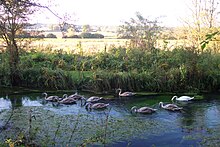River Pang
| Pang | |
|---|---|
 River Pang in Pangbourne | |
 | |
| Location | |
| Country | England |
| Counties | Berkshire |
| Villages | Farnborough, East Ilsley, Compton, Hampstead Norreys, Frilsham, Bucklebury, Stanford Dingley, Bradfield, Tidmarsh, Pangbourne |
| Physical characteristics | |
| Source | |
| • location | Varies between Farnborough, Compton and Hampstead Norreys |
| Mouth | River Thames |
• location | Pangbourne |
| Length | 23 km (14 mi) |
| Discharge | |
| • location | Pangbourne |
| • average | 0.62 m3/s (22 cu ft/s) |
| • minimum | 0.07 m3/s (2.5 cu ft/s)24 August 1976 |
| • maximum | 6.50 m3/s (230 cu ft/s)22 November 1974 |
| Discharge | |
| • location | Frilsham |
| • average | 0.21 m3/s (7.4 cu ft/s) |
| Basin features | |
| Tributaries | |
| • left | Maidenhatch Brook |
| • right | River Bourne |



The River Pang is a small chalk stream river in the west of the English county of Berkshire, and a tributary of the River Thames. It runs for approximately 23 kilometres (14 mi) from its source near the village of Compton to its confluence with the Thames in the village of Pangbourne.
The river, and its water voles, are thought to have inspired author Kenneth Grahame's character Ratty and his book The Wind in the Willows.[1]
Course
The river's source is normally near the village of Compton, although the exact location varies depending on rainfall levels. In times of high rainfall it can be traced back to Farnborough, some four miles to the west-north-west, whilst at other times it may be as far downstream as the outfall from Hampstead Norreys sewage works.
From Compton the Pang flows south through the villages of Hampstead Norreys and Frilsham, before turning east to flow through the villages of Bucklebury, Stanford Dingley and Bradfield.[2]
To the east of Bradfield the Pang is joined by the River Bourne and turns north to flow through the villages of Tidmarsh and Pangbourne, eventually entering the Thames between Whitchurch Lock and Whitchurch Bridge.[3]
The valley of the River Pang between Compton and Bradfield is rather isolated, penetrated only by narrow country lanes. Because of this isolation, the valley has not become the residential commuter area that is much of Berkshire, and is still largely agricultural.
Wildlife
The Pang contains American signal crayfish, which have displaced the native white-clawed crayfish species.[4]
The Berks, Bucks and Oxon Wildlife Trust owns a nature reserve straddling the Pang at Moor Copse, close to the village of Tidmarsh. A 29 ha (72-acre) extension to the nature reserve, in the area that is believed to have inspired Kenneth Grahame's work, was purchased in December 2006.[5]
In August 2007 a coalition of the WWF, the National Trust, the RSPB and others[6] called on the British government to adopt their Blueprint for Water. To publicize their campaign they highlighted the dangers to sites well known through literature such as The Lake District (Arthur Ransome's Swallows and Amazons and Beatrix Potter's Mrs Tiggy-Winkle), the North Kent Marshes (Charles Dickens's Great Expectations) and the River Pang.[1]
Water quality
The Environment Agency measures the water quality of the river systems in England. Each is given an overall ecological status, which may be one of five levels: high, good, moderate, poor and bad. There are several components that are used to determine this, including biological status, which looks at the quantity and varieties of invertebrates, angiosperms and fish, and chemical status, which compares the concentrations of various chemicals against known safe concentrations. Chemical status is rated good or fail.[7]
Water quality of the River Pang in 2019:
| Section | Ecological Status |
Chemical Status |
Overall Status |
Length | Catchment | Channel |
|---|---|---|---|---|---|---|
| Pang[8] | Moderate | Fail | Moderate | 36.57 km (22.72 mi) | 170.531 km2 (65.842 sq mi) |
Etymology
The river is named after a man, thought to be an early Saxon chieftain, or tribe called Pǣga who lived there in the post-Roman era.[9]
See also
References
- ^ a b Simpson, Aislinn (27 August 2007). "Waterways that inspired literary gems at risk". The Daily Telegraph. London. p. 11.
- ^ Ordnance Survey (2004). OS Explorer Map 158 – Newbury & Hungerford. ISBN 0-319-23612-9.
- ^ Ordnance Survey (2006). OS Explorer Map 159 – Reading. ISBN 0-319-23730-3.
- ^ Kennet & Pang Fisheries Action Plan
- ^ "Ratty's Paradise joins eight new reserves". Natural World. Spring 2007. p. 10.
- ^ "Board of Trustees". Wildlife and Countryside Link. Retrieved 21 September 2020.
- ^ "Glossary (see Biological quality element; Chemical status; and Ecological status)". Catchment Data Explorer. Environment Agency. 17 February 2016.
 Text was copied from this source, which is available under an Open Government Licence v3.0. © Crown copyright.
Text was copied from this source, which is available under an Open Government Licence v3.0. © Crown copyright.
- ^ "Pang". Catchment Data Explorer. Environment Agency.
- ^ Ford, David Nash. "Pangbourne". Royal Berkshire History. Retrieved 9 September 2020.
Further reading
Greenaway, Dick (2007). Around the Valley of the Pang. Dorcas Ward (illus.). Theale, Reading: Friends of the Pang, Kennet and Lambourn Valleys. ISBN 978-09543597-2-0.
External links
- Mapsources: source of the river grid reference SU 527,792 and mouth SU 634,766
- Pang Valley Countryside Project
- Kennet & Pang Fisheries Action Plan
51°29′10″N 1°05′17″W / 51.486°N 1.088°W
